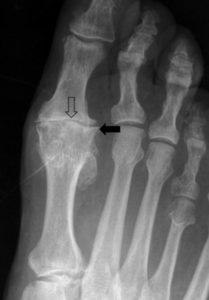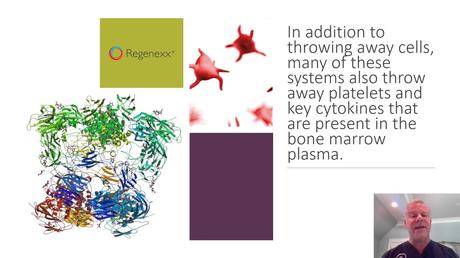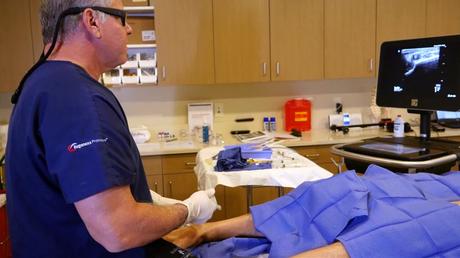Your mild, intermittent foot pain is now constant. Walking at times is almost impossible. Rest, medications, and physical therapy have not helped. Your doctor thinks it is arthritis. What are the 7 major causes of foot pain? What are the treatment options for foot pain? Are there effective alternatives to steroids and surgery? Are there different types of stem cells? What is stem cell treatment for foot pain? What are the advantages of stem cell treatment for foot pain? Let’s dig in.
Foot Pain (Can Affect Anyone)
Foot pain can be disabling and affects the young and old alike. Foot pain is a significant public health problem due to its high prevalence and negative impact on the quality of life. Foot pain affects 20–37% of community-dwelling adults 45 years and older(1). Foot pain affects one in four people aged over 75 years, two-thirds of whom have difficulty walking (2).
7 Major Causes of Foot Pain (Arthritis, Bone Spurs, Injuries to Tendons, Ligaments, Fascia, and Nerves)

Big Toe (1st MTP) Arthritis)
Foot pain can arise from a variety of different causes. The most common include:
Arthritis
There are several different types of arthritis which include rheumatoid, osteoarthritis, psoriatic, juvenile, infectious, and gout. Osteoarthritis is the most common type of arthritis in the foot. The big toe (MTP) is the most common area of osteoarthritis in the foot (3).
Bone Spurs
Bone spurs are boney growths that develop on bone edges. They vary in size and shape. Bone spurs on the heel can cause significant foot pain and disability. Age, increased weight, foot osteoarthritis, foot position, and history of plantar fascitis are factors that increase the risk of developing heel bone spurs (4).
Tendon Injuries
Tendons are thick pieces of connective tissue that connect muscle to bone. Tendons are susceptible to irritation and injury resulting in foot pain. The most common example is the Achilles tendon. The Achilles tendon is the thick cord in the back of your leg that connects your calf muscle to the heel. It can become irritated causing Achilles tendonitis or the tendon can tear resulting in significant foot pain.
Ligaments Injuries
Ligaments are thick pieces of connective tissue that connect bone to bone. They provide important stability for the foot and ankle. They are susceptible to injury including sprains or tears. Loose ligaments lead to abnormal, excessive movement in the foot and ankle which puts the cartilage and tendons at risk for injury. If left untreated ligament injuries can lead to foot arthritis and foot pain.
Fascia Injuries

Plantar Fascia
Fascia is a thin sheet of connective tissue that surrounds muscles, nerves, and other internal body organs. It stabilizes and separates the different structures. The fascia has nerve endings that make it sensitive. The most common example in the foot is the plantar fascia. The plantar fascia stretches from your heel to the front of your foot. If stretched or injured the fascia can become a source of significant foot pain and disability
Nerve Injuries
Nerves can be irritated, injured, or compressed resulting in foot pain. Common examples include tarsal tunnel syndrome, diabetic neuropathy, and neuroma. Tarsal tunnel syndrome is a painful condition in which the tibial nerve is compressed at the level of the ankle resulting in burning pain and numbness in the foot (5). Diabetic neuropathy is a type of nerve damage that occurs as a result of long term elevated blood sugar levels in type1 and 2 diabetics. Foot pain is a common symptom.
Referred
Referred pain is pain that is perceived in an area different from where the actual tissue injury has occurred (6). A common example is a patient who experiences arm pain while suffering a heart attack. The actual tissue injury is occurring in the heart but the sensation of pain is perceived in the arm. Foot pain can also be referred. In other words, it can come from areas outside of the foot. Irritation or compression of the low back nerves is the most common cause of foot pain.
Treatment Options for Foot Pain (Conservative Care, Injections & Surgery)
Conservative Care

Conservative care when appropriate should always be the first-line treatment. This would include rest, safe anti-inflammatory medications, physical therapy, chiropractic care, stretching, orthotics, and appropriate shoes.
Injections

When conservative care fails patients are often referred for steroid injections. Steroids have many different brands and names which include dexamethasone, methylprednisolone, betamethasone, and cortisone. Steroids are powerful anti-inflammatory agents that have a significant number of side effects. These include injury to cartilage, tendons, and ligaments (7). To learn more about the harmful effects of steroids please click here.
Surgery
When conservative therapy and injection therapy has failed many patients are referred for surgical evaluation. There are many different foot surgeries with varying levels of complexity. For example, some involve the insertion of a small camera into the joint to evaluate the cartilage whereas others involve the insertion of plates and screws and the fusion of the joint. The underlying problem and its severity will dictate the specific surgery. Beware as complications exist and include infection, damage, poor healing, failed fusion, adjacent segment disease, tendon rupture, and complex regional pain syndrome (8). Foot surgery can be life-altering. If you do not like the results you can not simply undo the surgery. Surgery permanently changes the mechanics of the foot and can create a new host of problems and complications.
Are There Effective Alternatives?
Stem cell treatment for foot pain is an effective alternative to surgery or steroids. Stem cells do not permanently change the mechanics of the foot nor do they have the toxic side effects of steroids. Stem cells are your own body’s powerhouses of healing. To learn more about how stem cells work please click on the video below

Are There Different Types of Stem Cells? ( Bone Marrow and Fat)
Stem cells are remarkable cells that can recruit cells throughout the body to assist in healing in addition to having the ability to differentiate into tendon, ligament, bone, and cartilage. There are several different types of stem cells which include:
Bone Marrow Stem Cells
Bone marrow-derived stem cells are the most common stem cell utilized at the Centeno-Schultz Clinic. The majority of all the research on stem cells and their healing potential to date has been performed using bone marrow-derived stem cells. These cells live in your bone marrow. They are harvested via a bone marrow aspirate which is a non-invasive procedure performed in our clinic. To learn how our clinic provides a superior bone marrow aspirate to ensure the best clinical outcome please click on the video below.

Fat Derived Stem Cells
Human adipose tissue (body fat) is a rich source of stem cells. Fat is extracted via a liposuction procedure the same day as the injections. The stem cells in fat are tightly bound in a fiberglass like material called the stroma. This is important as the stem cells are not as freely available to promote healing and therefore are inferior to bone marrow-derived stem cells
” Birth Tissue Stem Cells”
There has been an explosion of “birth tissue stem cells”. They have different commercial names and arise from different sources. Examples include Wharton’s jelly, amniotic fluid, and placenta. A forceful sales pitch is often utilized which includes:
1. Your stem cells are too old to be any good.
2. These vials contain millions of live and young stem cells that are very powerful.
The truth is that there are no living stem cells in the birth tissue products. Zero! To learn more please click on the video below

Stem Cell Treatment for Foot Pain
The specific stem cell treatment for foot pain will depend upon several factors:
- The type of tissue that is injured and its severity. For example, does it involve cartilage or just tendons?
- Is there joint instability?
- Is there a tendon injury?
- Is there a restricted range of motion due to scar tissue?
- Is there foot weakness due to irritation or compression of the low back nerves?
At the Centeno-Schultz Clinic, we are experts in the treatment of foot pain. We have extensive knowledge and experience with stem cells for common orthopedic conditions. In fact, we were the first clinic in the world to inject stem cells into the lumbar disc in 2005 We have an extensive list of peer-reviewed publications. There are many advantages of stem cell treatment for foot pain which include:
- Non-invasive (no incisions, hardware, or sutures as is the case with many surgeries
- Little downtime
- Identify and treat the underlying problems instead of masking them with medications
- Using your own cells to promote healing and recovery
The procedures are challenging and can not be performed by your PCP or orthopedic surgeon. It takes extensive experience in both ultrasound and x-ray guidance. To watch an advanced regenerative ankle injection please click below

In Conclusion
- Foot pain is real and can limit activity and quality of life.
- 7 major causes of foot pain: Arthritis, bone spurs, tendon injuries, ligament injuries, fascia injuries, nerve injuries, and referred pain.
- Treatment options for foot pain include conservative care, injections, and steroids.
- Stem cell treatment for foot pain is an effective alternative to surgery and steroids.
- There are two major sources of stem cells: Bone marrow and fat.
- Birth tissue products such as Amniotic fluid and Wharton’s jelly contain no living stem cells and should be avoided.
- The best stem cell treatment for foot pain depends upon many factors which include the site of injury, the severity of the injury, and the presence of tendon, ligament, or nerve involvement.
- The Centeno-Schultz Clinic are experts in stem cell treatments for foot pain. We were the first clinic in the world to inject stem cells into the low back in 2005.
- Advantages of using stem cell treatments for foot pain: little downtime, non-invasive, identifying and treating the source of the pain with your own cells.
If you or a loved one suffers from foot pain, please schedule a new patient consultation where you can learn what regenerative treatment options are best for you.
————————————————————————————————————————————————————
1.Dunn JE, Link CL, Felson DT, Crincoli MG, Keysor JJ, McKinlay JB. Prevalence of foot and ankle conditions in a multiethnic community sample of older adults. Am J Epidemiol. 2004 Mar 1;159(5):491-8. doi: 10.1093/aje/kwh071. PMID: 14977645.
2.Thomas MJ, Roddy E, Zhang W, Menz HB, Hannan MT, Peat GM. The population prevalence of foot and ankle pain in middle and old age: a systematic review. Pain. 2011 Dec;152(12):2870-2880. doi: 10.1016/j.pain.2011.09.019. Epub 2011 Oct 21. PMID: 22019150.
3.Roddy E, Menz HB. Foot osteoarthritis: latest evidence and developments. Ther Adv Musculoskelet Dis. 2018;10(4):91-103. doi:10.1177/1759720X17753337
4.Kirkpatrick J, Yassaie O, Mirjalili SA. The plantar calcaneal spur: a review of anatomy, histology, etiology and key associations. J Anat. 2017;230(6):743-751. doi:10.1111/joa.12607
5.Hudes K. Conservative management of a case of tarsal tunnel syndrome. J Can Chiropr Assoc. 2010;54(2):100-106.
6.Murray GM. Guest Editorial: referred pain. J Appl Oral Sci. 2009;17(6):i. doi:10.1590/s1678-77572009000600001
7.Wernecke C, Braun HJ, Dragoo JL. The Effect of Intra-articular Corticosteroids on Articular Cartilage: A Systematic Review. Orthop J Sports Med. 2015;3(5):2325967115581163. Published 2015 Apr 27. doi:10.1177/2325967115581163
8.Chrea B, Day J, Henry J, Cody E; HSS Orthopaedic Foot and Ankle Surgery Group, Ellis S. Influence of Complications and Revision Surgery on Fulfillment of Expectations in Foot and Ankle Surgery. Foot Ankle Int. 2021 Feb 1:1071100720985231. doi: 10.1177/1071100720985231. Epub ahead of print. PMID: 33525945.

